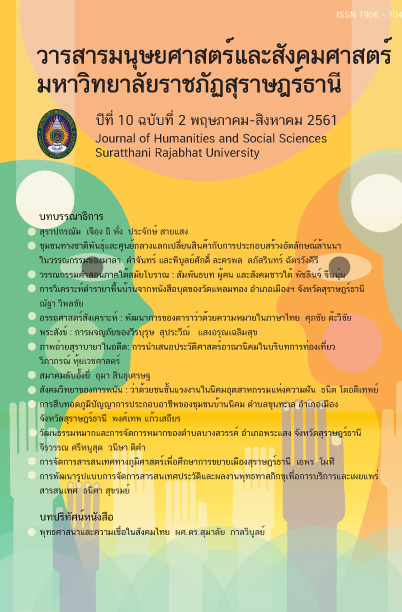The Photographs of Surabaya’s Past : A Representation of the Colonial Past in a Tourism Context
Main Article Content
Abstract
Abstract
This research article aimed to study the social and economic development of Surabaya that resulted in the rapid development of the Reformation tourism business as well as the reproduction and reinterpretation of photographs from the colonial period which was in the tourism period of Surabaya. The author analyzed the use of urban historical photographs in contemporary contexts by collecting information and photographs from the city museum and private stores which were rising under tourism context. According to the study, the historical photographs have been used as a mechanism to create new identities in order to meet the social and economic needs of Surabaya in decentralization period that the city try to promote tourism. As a result, the original meanings of the photographs have been abandoned and new descriptions have represented the background of Surabaya as a modernity of the past without touching the traumatic issues of colonial history, while private stores have reproduced the photographs as their products and presented the photographs of Surabaya in the past vibrantly.
Keyword: Surabaya, Photographs, Colonial, Tourism
Article Details
All published manuscripts have been verified by peer-peer professors in the fields of humanities and social sciences. Reprinting of the article must be authorized by the editorial staff.
References
Dick, H. W. (2002). Surabaya, city of work: A socioeconomic history, 1900- 2000. Singapore : Singapore University Press.
Indrianto, A. (2008). Interpreting the past: Creating the Surabaya heritage trial, Indonesia. In Janet Cochrane (Ed.), Asian tourism: growth and change (pp. 357-368). Amsterdam, Netherlands : Elsevier Benjamin.
McGregor, Katharine E. (2003). Representing the Indonesian past: The National Monument History Museum from Guided Democracy to the New Order Indonesia. 7(5), 91-122.
Peters, R. (2013). Surabaya, 1945-2010: Neighbourhood, state and economy in Indonesia’s city of struggle. Singapore : NUS Press.
Purnawan, Basundoro. (2009). Two Cities, Three Ages: Surabaya and Malang since the Colonial Age until the Age of Independence. Yogyakarta : Penerbit Ombak.
Purwono, Nanang. (2011). Surabaya Fortress: The Trace of the National Fence. Surabaya: Manukan Rejo.
Republic of Indonesia. (1979). Five-Year Development Plan (Third Issue), 1979/80-1983/84.
Reid, Antony. (2004). Southeast Asia in the Age of Commerce. 1450-1680: Volume 2, Expansion and Crisis. Translated by Pongsri Lekawatana. Chiang Mai: Silkworm.
Somkiat Tungnamo. (2006). Visual Culture. Mahasarakham : Mahasarakham University Press.
Strassler, Karen. (2010). Refracted visions: Popular photography and national modernity in Java. Durham,NC : Duke University Press.
Thanawi Chotpradit. (2010). Exhibition Phenomenon: Articles Relating to A Perspective on Contemporary Art. Bangkok : Assumption.
Theera Nuchpiam. (2009). Who Does History Serve? In Suwanna Kriangkraiphet (Ed), The History in Dimensions of Cultural Studies: Articles from the 7th Annual Anthropology Conference, Innovation in Cultural Studies. (pp. 12-16). Bangkok: The Princess Maha Chakri Sirindhorn Anthropology Center.
Widodo, Dukut Imam. (2013). History of Surabaya. Surabaya: Dukut Publishing.
.


